Contents
Arthrosis of the joints of the fingers and toes is a joint lesion that is inflammatory or degenerative in nature. If the distal interphalangeal joints most often suffer on the hands (although in a severe form of the course of the disease, all joints without exception can be affected), then on the leg, the big toe is usually included in the pathological process (but sometimes other joints can also suffer).
This disease affects everyone: both men and women.
But more often, representatives of the weaker sex still suffer. This is due to changes in the body of a woman during menopause, when, against the background of a general hormonal imbalance, the normal blood supply and nutrition of the joints are disrupted. But if at the age of about 45 years and up to 60 – the group of patients with arthrosis consists mainly of women, then after 60 the number of men suffering from such an ailment increases significantly. What is associated with natural age-related changes in the joints.
Causes of arthrosis of the joints of the toes and hands

There are the following reasons leading to the development of the disease, both on the hands and on the toes:
Age over 60 years.
The period of menopause in women.
Disorders in the work of the immune system. Frequent SARS arising against this background.
Past trauma, such as fractures, sprains, bruises.
Genetic developmental anomalies associated with a violation of the normal formation of the joints.
Working conditions that have a significant increase in the load on the joints of the arms and legs.
Wearing the wrong shoes: high heels, out of season, too narrow toe, etc.
Radiation.
Diseases such as: rheumatism, gout, diabetes mellitus, tuberculosis, rheumatoid arthritis.
Aggressive environmental factors: living conditions in constant cold, increased vibration, etc. Unfavorable living conditions in general.
Allergy.
Anatomical features of the foot, in particular, protruding bones.
Flat feet.
Hereditary factors.
Large body weight.
Metabolic disorders in the body.
Symptoms of osteoarthritis of the fingers and toes

A patient may be suspected of having arthrosis of the toes or hands by the following symptoms:
Pain in the area of the injured joint. Increased pain occurs at a time when the hand or foot is subjected to stress. It acquires a aching character during a night’s rest.
When moving the fingers, especially with intense flexion, a characteristic crunch is heard in the area of the damaged joint.
The appearance of seals, or nodules, they will be visible, even if we consider the hands from the side of the palms, and the legs from the side of the foot.
Swelling and constant muscle tension in the problem area.
The mobility of the foot bone is often impaired.
Violation of the normal position of the big toe.
Stages of development of arthrosis of the joints of the fingers and toes
The disease has three stages of development, in general, they are characterized by the same signs of damage, both for the joints of the fingers and toes with a slight difference:
The first stage is characterized by mild pain that occurs spontaneously, but they are of such intensity that the person does not pay attention to them. Although already at this stage there is a feeling of stiffness of the hand or foot.
The next stage is characterized by an increase in painful sensations that become regular, torment a person, both during the day and at night. The periarticular area is often edematous, the skin may turn red at times of exacerbation, and there is an increase in temperature. When moving, a crunch is heard. The muscles of the finger, and sometimes the feet and hands, may begin to atrophy. It is at this time that patients most often seek help from a doctor.
If the disease is not treated, then in the future the pain will become more intense, it will haunt the person constantly, regardless of the time of day or physical activity. The fingers and toes are deformed, their length may change. As the cartilage is destroyed, Heberden’s and Bouchard’s nodules will form. Mobility is severely limited. Secondary deformity is observed on the legs, that is, if only one finger was involved in the process at first, then the rest are subsequently deformed.
Treatment of arthrosis of the joints of the fingers and toes

Treatment of this pathology is reduced to the following measures:
Taking medications. To begin with, the doctor will prescribe anti-inflammatory nonsteroidal drugs to the patient. They are designed to have a depressing effect on the pathological processes occurring in the cartilaginous tissue. These drugs include: nimesulide, diclofenac, ortofen, and other drugs. Preparations from the group of chondroprotectors will be designed to help the affected cartilage recover, it can be chondroxide, glucosamine and other means.
Physiotherapeutic methods of treatment play an important role in the prevention and treatment of any arthrosis, including fingers and toes. Electrophoresis, laser therapy, ozonokerite baths, paraffin wraps are shown. Together with drug treatment, such procedures will help the cartilage recover faster, the pain will recede, and the metabolism will accelerate.
You can not do without a therapeutic set of exercises, which will be selected by the doctor individually, taking into account the stage of development of the disease. Useful are rotations of the feet and hands with varying degrees of intensity, rolling objects with the feet, fingering the rosary with fingers, etc.
A gentle massage aimed at improving the blood supply to damaged cartilage and relieving muscle spasm.
Surgical intervention, which consists in removing the damaged joint and all growths, and then replacing it with an artificial prosthesis.
Do not forget also about folk remedies. A variety of compresses and wraps can be used only in the absence of allergies and after consulting a doctor. Wraps based on wax or honey, taking warm baths with decoctions of herbs will be useful.
Compliance with a diet with the obligatory inclusion of alkaline foods in it: whey, sauerkraut, wild berries. Bone broth, dairy products, and rye bread will be useful.
The combination of all possible methods of treatment and prevention of the disease, it is possible to ensure that arthrosis of the fingers and toes ceases to disturb the patient, and the pathological processes slow down to a large extent.









